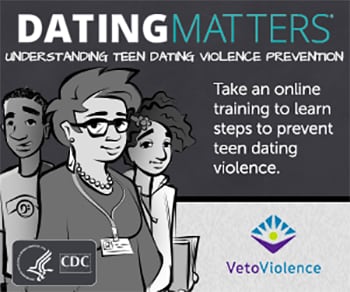Teen Dating Violence

February is Teen Dating Violence Awareness and Prevention Month.
Teen dating violence can be prevented when teens, families, organizations, and communities work together to implement effective prevention strategies. Learn how to prevent teen dating violence and promote healthy relationships with CDC’s online resources.
Background
Teen dating violence can be physical, emotional, or sexual, and includes stalking. It can occur in person or electronically, which includes texting, social media, and other online applications. In a recent national survey[12.1 MB], 8 percent of high school students reported physical violence and 7 percent reported that they experienced sexual violence from a dating partner in the 12 months before the survey. Victims of teen dating violence are more likely to experience symptoms of depression and anxiety. They might also engage in unhealthy behaviors, such as using tobacco, drugs, and alcohol. Teens who are victims in high school are at higher risk for victimization during college and throughout their lifetimes.
What You Can Do
Teaching healthy relationship skills and changing norms about violence can help prevent teen dating violence. Talk to teens now about the importance of developing healthy, respectful relationships.
What CDC Is Doing
CDC’s Division of Violence Prevention is leading the initiative, Dating Matters®: Strategies to Promote Healthy Teen Relationships. Dating Matters is a comprehensive teen dating violence prevention model that builds upon current evidence-based practice to promote respectful, nonviolent dating relationships among youth. Three components of Dating Matters are currently available on CDC’s VetoViolence website.
CDC also developed technical packages to help states and communities prioritize efforts to prevent or reduce public health problems, including teen dating violence and intimate partner violence.























.png)











No hay comentarios:
Publicar un comentario